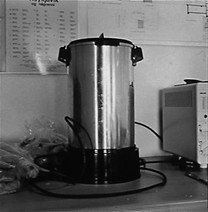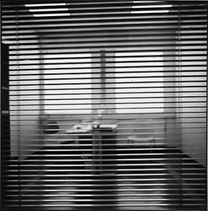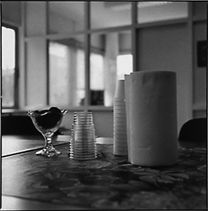| Ívar Brynjólfsson |
 |
 |
|
|
by Eiríkur Thorláksson
Occasionally exhibitions offer speculations about the nature of the medium which the artist has chosen to work with; what is its nature, how does it tie in with the subject matter and how does it relate to the times and the changing attitude?
These and some other questions are brought up in the show of Ívar Brynjólfsson, where the medium is black and white photography. Ívar has held three private exhibitions and participated in some group shows, where he has applied this medium in a rather unusual manner.
The series of photographs that are now on display at Gallery Ingólfsstraeti 8 stem from the presidential campaign in 1996. Judging from the title of the show, one would expect to see pictures of lively rallies, beautiful candidates, smiling children and singing supporters. This is the image that flares up in our minds when we think about candidates and elections.
There is no indication, however, of the hullabaloo and glamour we normally associate with such events in Ívar Brynjólfsson's photographs. There is no human presence, only the state of waiting which the candidates must endure. Uneasy tranquillity looms over these pictures, where expectations — or desperation — almost become palpable. Waiting is the most conspicuous part of the set-up: coffee machines, plastic cups, crackers, cookies, sodas, and soft drink dispensers wait for the crowds to arrive; announcements, postcards and posters wait to be mailed and phones wait to be answered. Flowers in windows and candles on tables are transformed into a symbol of the hopes evoked by the campaign, and either blossomed or got extinguished when the results were in.
(The daily Morgunbladid August 27, 1996. Transl. HS)

On the Grammar of Photography
by Gunnar J. Árnason
If one were to simplify and generalise, there are two dominant types of "artistic photography" in Iceland: the "visionary craftsman" and the "amateur conceptualist". The former represents the master craftsman that has a successful commercial practice and specialises in a particular subject and makes beautifully crafted photographs of interesting subject matter, people, places, events, landscapes. This type of photographer is exemplified by an interesting exhibition, at the Living art Museum, of the undisputed master of portrait photography in Reykjavik, Jón Kaldal. But if artistic photography means anything to the general public in Iceland it means landscape photography above all, and every year a few books appear of spectacular scenery destined for the tourist market.
The other type of artistic photography is the very opposite of the photographer-craftsman. He has absolutely no interest in the Art of Photography, and either takes amateurish photos himself or gets someone else to do it for him.
Conceptual artists, such as Sigurdur Gudmundsson, are the best known proponents of this type. Gudmundsson started off in the sixties using snapshots to document actions and happenings, then in the seventies he graduated to staging events or tableaux for the camera, in a sober black and white documentary style, but by the eighties his large scale colour photographs had become big and glossy. Then his involvement with photography came to an abrupt halt. By some accounts he had become to preoccupied with photography itself and needed to distance himself from the medium so as not to fall into the temptation of craft and technique.
So we have on the one hand photography as a craft, that is aimed at revealing to us Reality in a impressive manner. On the other hand we have photography taken basically as a technique, with user value, a vehicle of pictorial meaning, but no intrinsic artistic interest.
Ívar Brynjólfsson's work fits into neither category. At least one senses that his work is born out of the effort to differentiate himself from photography as craft and commercial enterprise, without assimilating his work to artistic practices that utilise photography, making it just another vehicle for artistic ideas.
The title of Ívar Brynjólfsson's series of photographs, "Pictures from the Presidential Campaign", on display at Gallery Ingólfstraeti 8, might suggest exciting press-photos of the candidates, lively campaign meetings and throngs of interesting people, but in fact they are actually quite dull. They are all taken at the campaign offices of the candidates for the Icelandic presidential election last spring, but in none of the pictures are there any people to be seen, only very "ordinary" objects, such as coffee pots and percolators, plastic cups, leaflets and telephones, lying around haphazardly, none of which appears to be of any relevant interest to the campaign. One can look in vain for any signs of the political reality. These photographs are mounted on panels and beneath each panel there is a short text describing each picture. All the texts have the same grammatical form: such and such a thing in the campaign office of such and such a person. In the lower right hand corner of each panel is a bar code, as can be seen on packaging of ordinary commodities.
How does one approach these photographs? If one approaches them as if they were the work of a visionary craftsman, a certain kind of interpretation would seem to offer itself, that would seek to describe their subject matter in such a way as to make it appear interesting; e.g. his images present a fly on the wall, a glimpse behind the scenes of the real campaign hidden from public view. Or one would maybe describe them as revealing the beauty of small things that go unnoticed, which stand in the shadow of great events. But this interpretative strategy doesn't really work. There is no attempt to make these objects and scenes in any way interesting or beautify them.
If on the other hand one took them as the work of the amateur conceptualist then the actual content of the photographs would be irrelevant. The text would be the key to the work and how the grammar of the text - "such and such" in the campaign office of "so and so" - serves as a prescription for the content of the pictures, where they are to be taken and when. The photographs would in that case become a part of the process of completing the concept.
This latter strategy appears to be more promising. The panels have the look and feel of conceptual art, and the bar code, for instance, suggests an ironic gesture, aimed at the commercialisation of the photographic image. But if Brynjólfsson's previous shows are taken into account, then one realises that he is first and foremost a photographer. One recent show consisted of images of rocks on the outskirts of town; before that show, a series of photographs of non-places like corners, walls, floors.
What then? This is where I hesitate and this hesitation, resulting from uncertainty about where this kind of photography is heading (Brynjólfsson's work is not the only example of photography which brings about such an onslaught of hesitation), happens to be the reason I find Brynjólfsson's photographic work intriguing. Not least, given the Icelandic context for photography.
Certain aspects of these photographs are not too difficult to understand. They are not about equipment, not about being skilful, a virtuoso. They are not about affecting us emotionally, informing us or impressing on us the value of things. And not about content or symbolism. There is a familiar stripping away of all irrelevancies, an asceticism of the signified, not allowing indulge in excess. One can sense in them an aesthetic indifference toward the things that the lens is directed at. One can maybe say that there is search for the photographic image in its raw state, before it becomes burdened with meaning, ideological connotations, pathos. But this also means that it is photography in a very indeterminate state, evasive and elliptical. It leaves one with an uneasy feeling, as if something is missing or has been lost, but what is lost is a meaningful correspondence between the photographic image and our beliefs about the things the image reveals to us.
(The Nordic art magazine Siksi no. 3, autumn 1996)
 |
|
|
 |
|
Asthor Magnusson |
 |
|
Asthor Magnusson |
 |
|
in the Presidential Office of Asthor Magnusson |
|
|
|
|
|
|
|
|